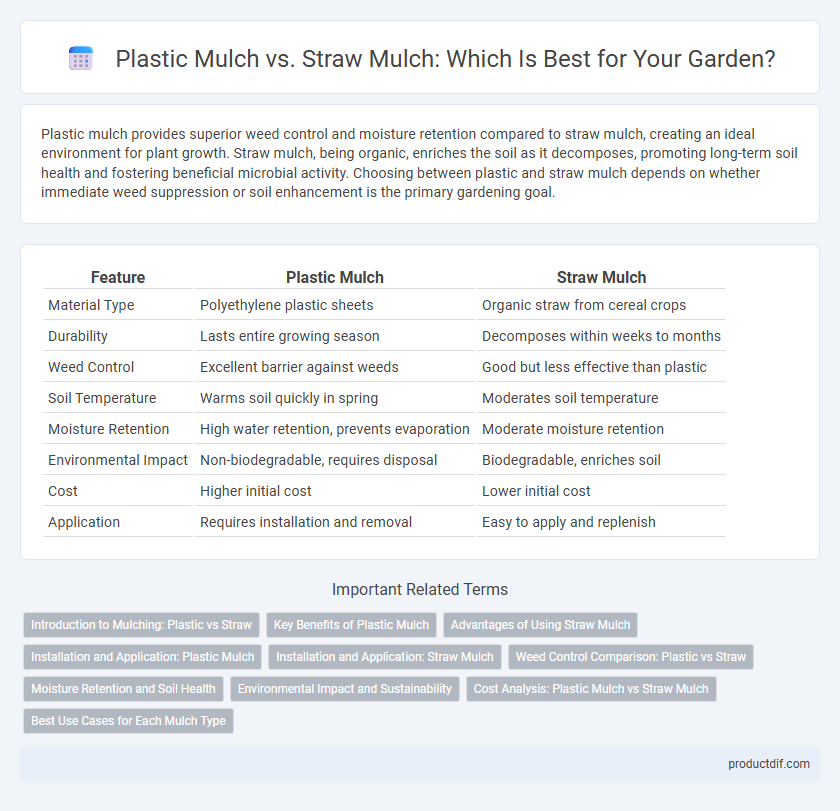Plastic mulch provides superior weed control and moisture retention compared to straw mulch, creating an ideal environment for plant growth. Straw mulch, being organic, enriches the soil as it decomposes, promoting long-term soil health and fostering beneficial microbial activity. Choosing between plastic and straw mulch depends on whether immediate weed suppression or soil enhancement is the primary gardening goal.
Table of Comparison
| Feature | Plastic Mulch | Straw Mulch |
|---|---|---|
| Material Type | Polyethylene plastic sheets | Organic straw from cereal crops |
| Durability | Lasts entire growing season | Decomposes within weeks to months |
| Weed Control | Excellent barrier against weeds | Good but less effective than plastic |
| Soil Temperature | Warms soil quickly in spring | Moderates soil temperature |
| Moisture Retention | High water retention, prevents evaporation | Moderate moisture retention |
| Environmental Impact | Non-biodegradable, requires disposal | Biodegradable, enriches soil |
| Cost | Higher initial cost | Lower initial cost |
| Application | Requires installation and removal | Easy to apply and replenish |
Introduction to Mulching: Plastic vs Straw
Plastic mulch offers superior moisture retention and weed control through its impermeable barrier, making it ideal for high-value crops. Straw mulch enhances soil fertility by decomposing and improving organic matter while allowing better water infiltration and aeration. Both materials affect soil temperature regulation differently, with plastic mulch warming the soil faster than straw mulch.
Key Benefits of Plastic Mulch
Plastic mulch provides superior weed control by creating a physical barrier that inhibits weed germination and growth. It enhances soil moisture retention and temperature regulation, promoting faster plant growth and higher crop yields. The durability of plastic mulch reduces soil erosion and nutrient runoff, leading to more efficient resource use in garden supply.
Advantages of Using Straw Mulch
Straw mulch enhances soil moisture retention by reducing evaporation and moderates soil temperature, creating an optimal environment for plant growth. It naturally decomposes, enriching the soil with organic matter and beneficial nutrients, promoting healthier crops. Straw mulch also suppresses weed growth effectively while being biodegradable and environmentally friendly compared to plastic mulch alternatives.
Installation and Application: Plastic Mulch
Plastic mulch installation involves unrolling sheets of polyethylene film directly over prepared soil beds, ensuring close contact to retain moisture and suppress weeds. It requires securing edges with soil or stakes to prevent displacement by wind and creating holes or slits for planting crops. This method provides a durable, moisture-retentive barrier, ideal for high-yield vegetable gardens and commercial farming operations seeking efficient weed control and soil temperature regulation.
Installation and Application: Straw Mulch
Straw mulch is applied by spreading a 2 to 4-inch layer evenly over garden soil, providing excellent weed suppression and moisture retention. Installation is straightforward, requiring only a rake or hands to distribute the straw without specialized tools, making it ideal for small to medium-sized gardens. Straw decomposes quickly, enriching the soil with organic matter and improving soil structure over time.
Weed Control Comparison: Plastic vs Straw
Plastic mulch provides superior weed control by blocking sunlight completely, preventing weed seed germination and reducing manual weeding efforts. Straw mulch offers moderate weed suppression by creating a physical barrier, but weeds can still grow through thinner layers or gaps. Choosing plastic mulch can significantly reduce weed pressure in high-maintenance gardens, while straw mulch supports organic practices with some compromise on weed control.
Moisture Retention and Soil Health
Plastic mulch excels in moisture retention by forming a barrier that prevents evaporation, making it highly effective in arid conditions. Straw mulch, while less efficient in moisture retention, improves soil health by adding organic matter and promoting beneficial microbial activity. Combining moisture retention with enhanced soil structure, straw mulch supports long-term fertility, whereas plastic mulch primarily boosts short-term water conservation.
Environmental Impact and Sustainability
Plastic mulch produces non-biodegradable waste that can persist in soil for decades, contributing to pollution and requiring energy-intensive disposal methods. Straw mulch, sourced from agricultural byproducts, naturally decomposes, enriching soil health and promoting sustainable gardening practices. Choosing straw mulch reduces plastic waste, supports soil biodiversity, and aligns with eco-friendly garden supply solutions.
Cost Analysis: Plastic Mulch vs Straw Mulch
Plastic mulch generally presents a higher initial cost due to material and installation expenses, but offers longer durability and weed control benefits that can reduce maintenance costs over time. Straw mulch is more affordable upfront and biodegradable, making it a cost-effective option for short-term gardens, but may require more frequent replacement and labor. Evaluating overall expenses involves balancing plastic mulch's upfront investment against straw mulch's recurring costs and ecological impact.
Best Use Cases for Each Mulch Type
Plastic mulch excels in commercial vegetable production and high-value crops by conserving soil moisture, controlling weeds effectively, and increasing soil temperature for faster crop growth. Straw mulch is ideal for organic gardens, perennial beds, and erosion control by enhancing soil structure, adding organic matter, and supporting beneficial soil microbes. Choosing plastic mulch benefits short-term productivity with low maintenance, while straw mulch suits long-term soil health and sustainable gardening practices.
Plastic Mulch vs Straw Mulch Infographic

 productdif.com
productdif.com